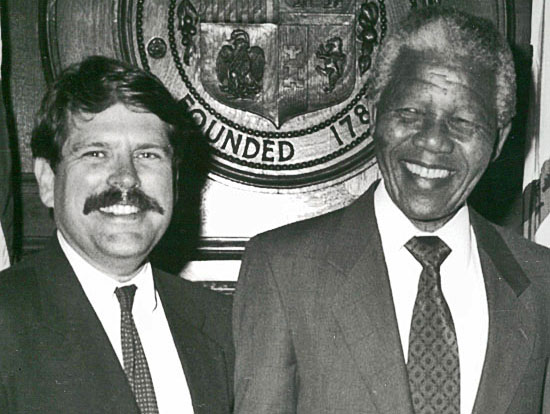The day I met Mandela
December 10, 2013
Los Angeles City Hall has played host over the years to heads of state, visiting dignitaries and many of the world’s great and near-great.
But one visit on June, 29, 1990 by a smiling septuagenarian fresh out of a South African prison stands in a class of its own.
Crowds waited hours in the sun to see Nelson Mandela, the living embodiment of the struggle against apartheid, as he came through our city on what all of us sensed was a march of destiny for his country and the world.
Mandela was introduced by Gregory Peck, embraced by Sidney Poitier and lauded as a hero by Mayor Tom Bradley. Harry Belafonte was there that day with his video camera. I’d brought mine from home, too, and we ended up videotaping each other.
The atmosphere was electric as thousands waited for a glimpse of Mandela. Some climbed trees, craning to get a better look.
Just five years earlier, while Mandela was still imprisoned on Robben Island, I had as a Los Angeles city councilman helped lead divestiture efforts that prompted withdrawal of city deposits from banks doing business in South Africa and halted some pension fund investments in companies with connections there.
Now, here was Mandela himself, paying tribute to those actions and many others that were bringing inexorable pressure to the fight to end the inhumanity of apartheid.
“Thank you for supporting us when we needed you most,” Mandela told us that day. “Thank you for remembering us even though we were incarcerated in prison dungeons thousands of miles away from here. Thank you for caring. We are on freedom road, and nothing is going to stop us from reaching our destination.”
After the speeches, at a reception hosted by the mayor, I had a chance to shake Mandela’s hand and exchange a few words with him. There was so much I wanted to say about my admiration for him, but with the crush of people all around us, there was only time to exchange a few casual pleasantries. Still, it was an opportunity I treasure to this day.
Not just because it was a chance to meet a personal hero, someone I’d admired from afar since my own early days as a human rights activist. But also because of what he showed the world following his release after 27 long years in prison. It was inspiring and remarkable to me that when he came out, retribution was not on his agenda—reconciliation was. When he went on to lead South Africa as its president, he was inclusive. Healing his beloved country would take working together, and no one showed the power of a collaborative spirit more than Mandela.
He set an enduring example of cooperation and selflessness that’s not often seen in public life these days.
As Mandela was memorialized after his death last week at the age of 95 by leaders including President Barack Obama in Johannesburg, I found myself thinking about the power of individuals to change the world—the importance of taking a public stand against injustice, and of lending our vocal and moral support to those, like Mandela, who put their necks on the line for a cause greater than themselves.
Every generation has its heroes—those all-too-rare individuals who stand up and make a difference. In our times, they’ve included the late Andrei Sakharov, the “voice of conscience” against human rights abuses in the Soviet Union and the inspiring Aung San Suu Kyi in Burma. But no one, I would argue, had the impact and experience of Mandela, who paid such a profound price in terms of the years of solitary confinement, yet emerged from behind bars to see the comparatively swift demise of the apartheid system he fought so effectively against.
He stands alone. And those of us fortunate enough to have even once crossed his path will always stand in awe.
Posted 12/10/13













 405 bridge work causes a stink
405 bridge work causes a stink





